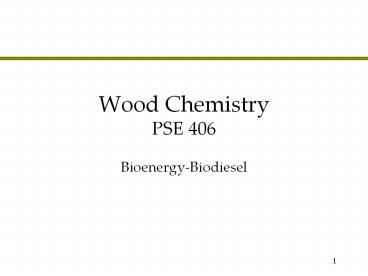Wood Chemistry PSE 406 - PowerPoint PPT Presentation
1 / 17
Title:
Wood Chemistry PSE 406
Description:
PSE 406 Bioenergy-Biodiesel Agenda Why biodiesel? How to make it? Possible sources Cars Biodiesel Bioethanol Rudolf Diesel The use of vegetable oils for engine ... – PowerPoint PPT presentation
Number of Views:152
Avg rating:3.0/5.0
Title: Wood Chemistry PSE 406
1
Wood ChemistryPSE 406
- Bioenergy-Biodiesel
2
Agenda
- Why biodiesel?
- How to make it?
- Possible sources
- Cars
- Biodiesel
- Bioethanol
3
Rudolf Diesel
- The use of vegetable oils for engine fuels
may seem insignificant today, he argued, but
such oils may become, in the course of time, as
important as petroleum and the coal-tar products
of the present time."
4
Biodiesel
- Biodiesel is not the same thing as raw vegetable
oil. It is produced by a chemical process which
removes the glycerol from the oil. - Biodiesel
- Domestic
- Renewable
- For diesel engines
- Derived from natural oils and fats
5
Why biodiesel?
- Biodiesel
- Biodegradable
- Non-toxic
- Lower gas emission that diesel when burned
(reducing green house gases by at least 68) - Commercially available in Europe and USA
6
Biodiesel
- Biodiesel is typically produced by a reaction of
a vegetable oil or animal fat with an alcohol
such as methanol or ethanol in the presence of a
catalyst to yield mono-alkyl esters and glycerol,
which is removed.
7
How?
- Tranesterification alcohol ester ? different
alcohol different ester - Base of acid as a catalyst
- The oil is mixed with an alcohol, usually
methanol or ethanol, and separated into methyl
esters (biodiesel) and glycerol.
8
Transesterification
9
Biodiesel technology
10
(No Transcript)
11
Possible sources
- Vegetable oil (soy, canola, coconut etc.)
- Recycled cooking oil (McDonalds fryer)
- Animal fats (fish oil)
- Soybeans
- Algae
12
Algae to biodiesel
- 1 acre of
- Corn-300gallons of ethanol/year
- Soybeans-60 gallons of biodiesel/year
- Algae-5,000 gallons of biofuels/year (cost)
Greenfuels bioreactors
13
Palm oil (1)
- Palm oil plantations is approximately 11 million
hectares (2006) in the world - Conversion of tropical forest in Asia into palm
oil plantation - Habitat destruction and potential extinction of
certain endangered species (e.g. the orangutans
in Borneo, the Sumatran tigers and Asian
rhinoceros) no word on Brazilian Pluto
14
Palm oil (2)
FAOSTAT
15
Palm oil (3)
- Palm oil is derived from the plants fruit
- A hundred kilograms of oil seeds typically
produce 20 kilograms of oil - Crude palm oil is extracted from the yellow parts
of oil palm fruit
16
Biodiesel cars
- The 86 fuel economy compared to 100 gasoline
- A smoother running engine due to the cleaning and
lubricating properties of the fuel. - Other benefits
- Better smelling exhaust (french fries or a warm
waffle iron). - Special materials required for fuel lines, hoses,
valves, gaskets
17
Flexible-Fuel Vehicles (FFV)
- Use E85 (85 ethanol and 15 gasoline)
- Cost of FFV is similar to traditional gasoline
vehicle - 1gallon of E85 provides the same energy as 0.72
gallons of gasoline (lower E content) - Special materials required for fuel lines, hoses,
valves, gaskets, fuel tank (corrosive ethanol) - Washington state more than 35, 000 of FFVs (U.S.
over 4 million FFVs) - Ford Focus, Chrysler Sebring, Dodge Stratus,
Dodge Caravan, Chevrolet Avalanche































